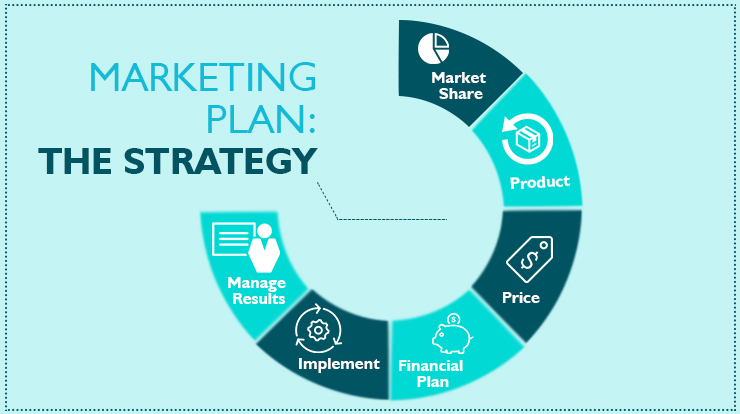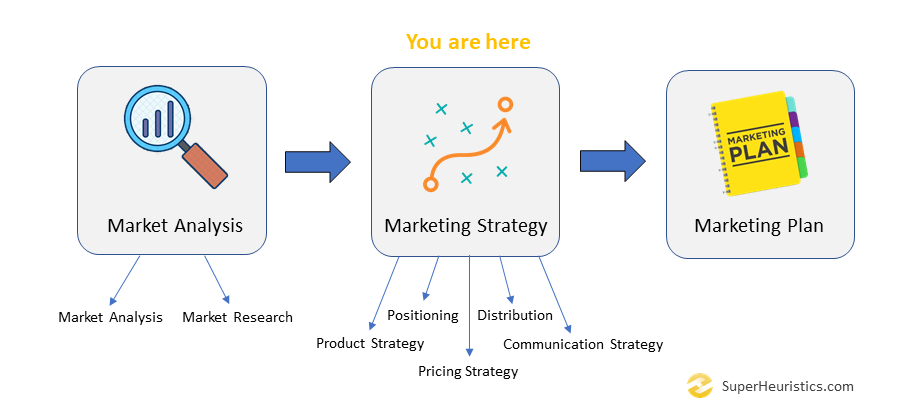
I shall continue this article from where I had left in Part 1 of this series on creating a Marketing Plan. In the previous piece, I talked about how any business plan, or in this case the marketing plan, begins with a market analysis.
From the standpoint of developing a full-fledged marketing plan, we are currently at this point, as shown in the image below

Creating a marketing strategy is not just about being creative or inventing new solutions. In fact, it’s a very structured work. You need to be sure that you know of what you are going to do step-by-step, and you should perfectly know each of these steps.
Let’s start with explaining some of the basic steps in creating your marketing strategy:
Set clear Marketing Objectives
In order to set clear marketing objectives, you need to ask yourself these questions:
What is the desired outcome of your marketing plan?
Do you have realistic objectives, targets, and a clear timeframe?
To be able to respond to those questions you need to know how to use marketing metrics to your advantage and to estimate the return on any investment that you will do in marketing.
Some of the Marketing Metrics are such as:
- Total Market Share: This metric helps you to understand how many people in the will buy your products or services out of all the products and services in your industry (or competition). In other words, the analysis of a situation like, if we have 10 clients for product X and three companies producing it, how many clients will each company have.
- Segments: If you did a good job when you did your research, the demographics will help you estimate how customers in the entire market are available for you.
- Retention rate: This metric tracks the activities of your customers and measures in a given time how long they will continue to purchase your products and services.
- Penetration rate: This measures the number of sales that you can get from the marketing total and also all the actions to increase it. The proportion of your potential market that completes the purchase.
- The average size or the volume of purchases: This is very easy to understand as the name itself says, it is the economic value of the purchases in your market share.
Determine your Marketing Strategy
Now it’s time to look at how you will best promote your product or service to your prospective customers.
Your marketing strategy should be revolving around the four Ps of marketing:
- Product
- Place
- Price
- Promotion
For that matter, for any marketing strategy to do well, all the 4Ps should be absolutely in coordination with each other and should be consistent.
And these four certainly are the defining 4 points of your entire marketing strategy. Every business has different requirements to do well and the 4Ps factors in all of that. Each P needs to be thought out carefully.
For example, don’t always assume you have to spend money on costly advertising. Say, if you have a niche audience, you can take advantage of low-cost marketing strategies such as e-mail, referral, and networking.
The bigger expenses are usually advertising, sales promotions and public relations campaigns. Digital marketing is a powerful strategy because it is inexpensive and effective in reaching target markets.
Create your Financial Plan
A Marketing Plan without financials has no way out. Try to create a budget and sales forecast, keep it very simple and easy to understand but very efficient.
Ask yourself:
- How much do you expect to sell?
- What will it cost to produce your products or deliver services?
- What will be your basic operating expenses? Be sure to include recruitment costs and salaries here
- What will you be charging?
- How much financing will you need to run your business?
These questions will help you determine your projected income and expenses, which are also vital. A break-even analysis is another important step when you are developing your marketing plan.
This will help you understand just how much you need to sell in order to cover your costs of operating your business.
Overall, you can determine your projected income and expenses.
Now, let’s go into what all needs to be covered in a Marketing Plan. I will give you some homework where you will find an easy marketing plan step-by-step. Can you apply it to your idea or a product/ services that you have already in use?
Marketing Plan Follow-Through Guide
- Executive Summary – Short summary of main goals and recommendations so that leadership/management team can get a quick idea of the key points.
- Current Situation (or a 5C Analysis) – Overview of the market
- Market description – What is the market? Who is the market? What are the trends?
- Environment – What is happening at a macro level and a micro level? What is the potential impact to the business?
- Competitive review – Discuss both direct and indirect competitors. Include a SWOT of main competitors along with their market position, sales, pricing, distribution, marketing strategy and marketing programs.
- Channel and logistics review – Include sales team, partners, e-commerce, referrals and delivery systems.
- Product review – Include information about your offerings, sales, gross margin and stage of the product lifecycle.
- SWOT – Perform an assessment of your company’s strengths, weaknesses, opportunities, and threats.
- Objectives and Issues – In a given period of time (the one that the plan covers) Select the objectives and goals that your marketing must reach and spot any possible issues.
- Marketing Strategy – This is how your company plans to engage customers, deliver value, create strong relationships and attain the business and marketing objectives.
- Positioning – What makes you distinctive in the mind of a customer? Would your customer agree?
- Value proposition – Why would someone buy from you vs. a competitor?
- Product Strategy – What is the roadmap (or future plan) for the product?
- Pricing – What is the pricing strategy (e.g. economy, luxury) and should it be revised?
- Distribution – What channels are used to move the product through the supply chain? Are there improvements or new channel opportunities?
- Marketing Communication Strategy
- Lead generation/Sales – Identify the programs that will be used to generate sales and/or leads for sales teams.
- PR – How will you share news, get mentions and build credibility?
- Online and Offline – What types of programs, tools, and resources do you need to reach objectives? This can include advertising, content, and sponsorships.
- Mobile – This should be part of any communications strategy. It is called out here because it is such an important communication channel.
- Events – What trade shows, conferences, and other events will contribute to reaching the objectives?
- Market Research – This is important, as ongoing research to understand your customers and market is critical. This will help you monitor and be aware of the perception (what is being said) about you the in the market.
- Action programs – The details to turn the strategies into a calendar of programs.
- Financials / Budget – The costs of all related programs including anticipated sales, revenue and costs of all marketing related activities.
- Controls – The KPIs you will use to measure results.
This article discussed in detail about marketing strategy and how to formulate a marketing plan. You must note that all the parts of marketing plan together make the complete layout of how are you going to do marketing in your business.
The subsequent articles in this series will discuss a few other important aspects of a marketing plan.







